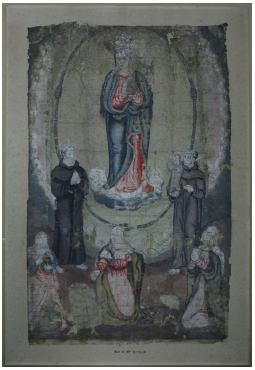Introduction
Nanban art refers to a wide variety of artistic expressions that arose from the interactions between Japan and the Iberian world in the early modern era. Their direct contact began with the arrival of St. Francis Xavier in Japan in 1549, and ended as a result of the ban on Christianity in 1614, and the consequent break in diplomatic and commercial relations with the Iberian monarchies in 1639. This period is known as "Christian Century"1 or Nanban era. The latter term, meaning "southern barbarians", is derived from the Chinese historical concept that regarded all peoples living outside of the Chinese civilization as barbarians2. Chinese called the natives from South Asian countries nanban. In the Japanese language, the word nanban began to be commonly used since the 16th century to refer to Portuguese merchants and missionaries, who came to Japan through South Asia, as well as to Spaniards, who came from the Philippines3. But, strictly speaking, the concept of nanban-jin or "southern barbarian people" included Italian Jesuits, and Spanish American friars. It is worth noting that in Japanese sources, the term nanban includes Europe and the Americas, as shown in the records concerning the embassy of Hasekura Tsunenaga (1571-1622) in Teizankdjikekiroku 貞山公治家記録, compilated by Date clan in 1703. That is, New Spain was called Nanban-koku 南蛮国 (Country of Southern Barbarians), while the term Oku-Nanban-koku 奥南蛮国 "Country in the back of Nanban" referred to Europe4.
Meanwhile, by reflecting that the term nanban connotes originally a Japanese historical perspective, Yayoi Kawamura has reconstructed the vision of nanban art from the opposite side, namely, that of the Spanish empire. According to the European perspective, all of Asia and the Americas were regarded as "Indies". Therefore, the Japanese lacquer works are referred to as "Indian works sent from Japan" in documents5. Instead, Mexican colonial documents often call Asian works "Chinese" without making distinctions between India, China, Japan, Korea, and the Philippines. But, it is not until the early twentieth century that the word nanban became a term of Cultural History and Art History. In that time, the research on nanban culture and Catholic globalisation in early modern Japan gained historical importance in both Western and Japanese academies. Since then, nanban studies as a specialized area have been developed for a century. This paper is structured in two parts. The first part addresses a historiographical overview of the advances in the study of nanban art.
This review aims to show how the idea of nanban art which was initially understood as the result of cultural exchanges between Japan, Portugal and Spain, has been redefined due to advances in research. Indeed, cosmopolitan features of nanban art, and its influences in diverse regions of the world are increasingly recognized today. Especially, this work clarifies the importance of including Spanish America in current debates. The second part exemplifies, with a specific case, the influence of nanban art in New Spain. We focus on the impact of nanban folding screens by the Kanô school of Kyoto and Catholic works produced by Japanese disciples trained in the Jesuit painting school on the mural painting The great martyrdom of Japan in 1597 in Cuernavaca, Mexico.
Historiographical Overview
Advances in the Study of Nanban Art
The study of nanban art has its antecedents in the records concerning Christian images and devotional objects, prepared by Confucianists in the late Edo period, as shown in Kirishitan hôfuku shokibutsu mokuroku 吉利支丹法服諸器物目録. (The inventory of kirishitan costumes and articles, 1800) by Tachihara Suiken (1744-1823), and Kinjôhiun 金城秘韞 (commonly known as Document of articles of Hasekura Tsunenaga, 1812) by Ôtsuki Gentaku (1757-1827)6. After Japan's reopening to the world and the Meiji Restoration in 1868, Western authors such as Léon Pagès (1814-1886)7, and British diplomat Ernest Mason Satow (1843-1929) wrote the first historical and linguistic monographs on cross-cultural exchanges in the early modern era8. In the field of art history, Ernest F. Fenollosa (1853-1908), American orientalist and professor of aesthetics at Tokyo Imperial University (now University of Tokyo), stated a possible influence of Venetian painting on the chromatic richness of the works by Kanô Eitoku (1543-1590), painter protected by Oda Nobunaga (1534-1582) and Toyotomi Hideyoshi (1537-1598)9. Although this hypothesis was not accepted, the relationship between the missionaries and the painters of the Kanô school of Kyoto, and the European influence on Japanese art would later become main research lines.
In the early 20th century, the study of historical and cultural exchanges between Japan and Iberia, as well as that of Catholic globalisation in East Asia took importance as a result of the 300th anniversary of the martyrdoms of Japan. Furthermore, the nanban culture boom took place as part of the Taisho Romanticism (1912-1926), as seen in the nanban literary movement10. Kosaku Hamada (1881-1938) founded a specialization in Early Christian Archaeology & Art in Kyoto Imperial University (now Kyoto University). Kyoto and its nearby regions -known as the "Cami" (Kami 上, "upper") in the Jesuit sources11- were one of the major mission sites. Hamada and his collaborators Izuru Shinmura (1876-1967), and Sueji Umehara (1893-1987) contributed to the recording and analysis of Catholic material remains in Japan such as Christian tombs, lacquer objects with the IHS emblem of the Jesuits and depictions of nanbanjin12. Particularly noteworthy are the findings of three Japanese Catholic paintings in Ibaraki City, Osaka, the former territory of the Christian feudal load Takayama Ukon (1552-1615). The portrait of Saint Francis Xavier (see figure 1) was found tied up on a roof beam of Tojiro Higashi's house in 1920, and is now owned by the Kobe City Museum. The other two works The Virgin Mary with the Infant Jesus and Her Fifteen Mysteries, Loyola and Francis Xavier have a similar composition and iconographic program. One was found in the Higashi family's house in 1920, and belongs today to the Ibaraki Municipal Christian Heritage Museum (see figure 2), while the other was discovered in 1930 hidden in the roof of the Harada family's house, and now is owned by the Kyoto University Museum (see figure 3). Hamada and Shinmura kept photographic records and descriptions of these paintings, and argued their historical value13. These material remains were classified by these scholars as kirishitan ibutsu "Christian relics", since the Japanese converts in the early modern era were called kirishitan, term derived from the Portuguese word christao. At the same time, the artwork that emerged from a contact between Japan and the Iberian world began to be called nanban bijutsu, literally meaning "southern barbarian art".
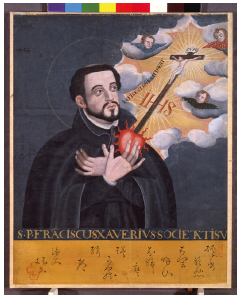
Source: signed with “Gyofukanjin 漁夫環人” and attributed to Cano Pedro. Late 16th and early 17th centuries. Watercolour on paper. 61 x 48.7 cm. Kobe City Museum (Kobe, Japan).
Figure 1 The portrait of Saint Francis Xavier
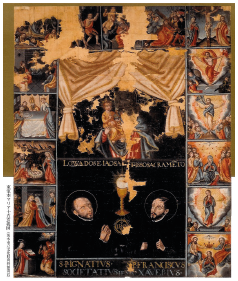
Source: Higashi family's version. Unknown Japanese (school of Giovanni Nicolao). Early 17th century. 84.2 x 67.1 cm. Ibaraki Municipal Christian Heritage Museum (Ibaraki City, Osaka, Japan).
Figure 2 The Virgin Mary with the Infant Jesus and Her Fifteen Mysteries, Loyola and Francis Xavier
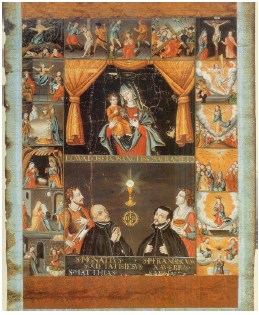
Source: Harada family’s version. Unknown Japanese (school of Giovanni Nicolao). Early 17th century. 102.7 x 70.7 cm. The Kyoto University Museum (Kyoto, Japan).
Figure 3 The Virgin Mary with the Infant Jesus and Her Fifteen Mysteries, Loyola and Francis Xavier
Simultaneously, Nagasaki became other center for kirishitan or nanban studies. Tokihide Nagayama (1867-1935) and Tokutaro Nagami (1890-1950) conducted research from the perspective of local history. Nagayama, first director of the Nagasaki Prefectural Library, prepared several catalogs concerning the kirishitan art preserved in his town14. These records acquired testimonial value over time, since the works belonging to the Urakami Cathedral in Nagasaki were lost due to the dropping of the atomic bomb in 1945. Meanwhile, Nagami, a dramatist from Nagasaki and collector of historical documents and nanban folding screens, published catalogues raisonnes on nanban art15. He inferred that the painters of nanban screens who depicted detailed Catholic scenes could freely enter the churches and observe liturgical celebrations. Some of those painters must have even converted to Christianity16. Jesuit historians also contributed greatly to nanban studies. German orientalist Joseph Dahlmann (1861-1930) -who arrived in Japan in 1903 to establish a Catholic institution of advanced studies in Tokyo, later known as Sophia University- focused his attention on the cultural exchange between Japan and the West during the Momoyama period (ca. 1568-1600). He stated the historical and testimonial value of nanban folding screens. Namely, the precision of details suggested that the painters of the Kanö school had been in Nagasaki at the beginning of the 17th century to directly observe the trade with the Iberians17.
Georg Schurhammer (1882-1971)18 and Joseph F. Schütte (1906-1981) carried out exhaustive documentary research. They disclosed unpublished data on missionary work of the Society of Jesus in Japan, including artistic activities in the so-called "seminarium pictorum" or "schola pictorum", which was founded by Italian Jesuit Giovanni Nicolao (Niccolö or Cola, 1560-1626) in the "Ximo" (Shimo ~f, "lower") region (present-day Kyushu) in the mid-1580s19. Diego Pacheco (also known by his Japanese name Ryögo Yuki, 1922-2008), former director of the Twenty-Six Martyrs Museum in Nagasaki, contributed to the development of early Japanese Catholic studies in the Kyushu region. Based on missionary documents, this author reconstructed lost Catholic churches in Nagasaki20. He also analyzed the origin of the hana-kurusu, "cross in the shape of a flower", a common motif in Japanese Christian works (e.g. stone tombs, roof of the Dominican church of Santo Domingo in Nagasaki), and attributed its design to Nicolao21. Fernando García Gutiérrez (1928-2018), specialist in Japanese art history and former professor at the Sophia University, delved into the contributions of the Society of Jesus in the artistic exchange between Japan and the West in the early modern era. Nicolao is regarded as the key figure in this cross-cultural experience, since he taught his pupils techniques of oil painting and copper engraving. He was also a distinguished mathematician and a skilled manufacturer of clocks and bamboo organs. García Gutiérrez disclosed small paintings on copper plate depicting The Virgin and Child, produced by Nicolao's school, and now housed in the churches in Seville22. He noted the use of Flemish prints by Hieronymus Wierix as visual sources of those works23. This historian also investigated the iconography of Francis Xavier in the kirishitan art (including the works by hidden Christians of Nagasaki)24.
As noted above, the influence of European culture on the Japanese art of the Momoyama period became a predominant research line over the last century. Several Japanese and Western authors such as Shinmura, Akiyama, Nishimura, McCall, Boxer, and Okamoto focused on the contributions of Nicolao's school: the introduction of European pictorial traditions, copper-plate engraving, mission press, and the formation of pupils25. These studies included analyses of formal and iconographic features of nanban folding screens painted in the Western style, and identification of their figurative sources, besides studying the works of the Kanó school depicting the arrival of the Portuguese ship in Nagasaki, Iberian merchants, and missionaries. In particular, the research conducted by Nishimura for over 30 years using Japanese and European sources was remarkable. In his book, entitled Nanban bijutsu (1958), the author compiled several of his previously published papers addressing different genres of nanban art: cave chapel, painting, fumie26, lacquer, pottery, and swordguard27. However, the aesthetic values of Japanese Catholic paintings were judged from a Eurocentric point of view in all these studies. The works that were not made in accordance with the Western canons were little appreciated. Thus, hidden Christian paintings that were characterized, to a great extent, by indigenization were worth nothing as "works of art", although their historical and devotional values were recognized28.
The circulation, production, and use of nanban screens were also addressed since the mid-20th century. Based on missionary records and other sources, Boxer reported that Alessandro Valignano (1539-1606) presented to the Pope folding screens that he had received from Oda Nobunaga. This Jesuit Visitor also ordered the making of a screen representing the geography of China in Macau, and another one depicting Rome and other European capitals. At least, the latter was actually produced and belongs today to the Kobe City Museum29. Similarly, a pair of gold-leaf screens was presented to Shah Abbas the Great of Persia by the Portuguese in 1608. Boxer also noted that, according to the Jesuit "Obediencias" of 1612, the unnecessary use of screens in cells was forbidden. This suggests a great popularity of folding screens30. A research on the circulation of Japanese export lacquer from the Edo period (1603-1868) in the Netherlands, Germany, England, and Denmark arose out among Western scholars from the 1950s, since a large majority of nanban lacquerware belonged to European collections31. Diverse artistic legacies on these objects were observed, as Martha Boyer stated- the use of gold and silver powder, together with Korean mother-of-pearl inlay techniques, and West Asian decorative patterns handed down via China (e.g. serrated motifs, shoots)32. Identifying diverse artistic legacies on nanban export lacquer was going to become the focus of research and discussion, as will be mentioned below.
Collecting and exhibitions were key factors that promoted a systematic study and dissemination of nanban art, also in Japan. After World War II, many objects came onto the international art market, and began to be returned to Japan. Yoshiro Kitamura founded the Nanban Culture Museum in Osaka in 1967, and published catalogs of his collection33. Several important events such as a nanban lacquer exhibition were held at the Tokyo National Museum in 1969 and in the 1970 World Exposition in Osaka. In the latter, lacquerware belonging to the Museu Nacional de Arte Antiga in Lisbon was exhibited. This raised Japanese people's awareness about the importance of nanban lacquer collections outside of the country. The Japanese Ministry of Education sent specialists such as Motoo Yoshimura to research nanban lacquer preserved in Europe in 1972-197334.
After the 1970s, Hirakazu Arakawa and Akio Haino addressed nanban lacquer, distinguishing export works from those for domestic use. Nanban lacquer was classified into two groups: the first included works made according to the order and taste of the Iberian, such as Catholic liturgical objects (e.g. hostiaries, triptychs, and lecterns), and pieces used by Westerners in daily life (e.g. host boxes, chests, and cabinets), while the second grouped works produced for domestic use. Arakawa stated that a pattern of export lacquer could have been created according to the tastes and needs of Westerners. In addition, these works must have presented a "Japanese identity". The above-mentioned author also pointed out that what is known today as nanban lacquer included pieces exported even after the severance of diplomatic and commercial relations with the Iberian world in 1639, since non-religious pieces continued to be exported by the Dutch East India Company35. Therefore, the concept of nanban culture could not be clearly separated from komo "red hair" one, which refers to the culture given through contact with the Dutch.
From the point of view of techniques and decorative patterns, nanban lacquer shares many characteristics of other Momoyama lacquer pieces, especially Kodaiji-type maki-e, and Ryukyu lacquerware, as noted by Arakawa and Haino36. Kodaiji is a Zen temple founded in honor of Toyotomi Hideyoshi by his wife Kodai-in in Kyoto in 1606. Maki-e refers to a technique of drawing on the lacquered surface using gold or silver powder before it dries. Kodaiji-type maki-e is characterized by simplified techniques, as shown in hira maki-e (flat lacquering)37. The devising of new methods that enabled rapid production responded to an increase in domestic demand for lacquer in castles, feudal lord mansions, and temples. Different techniques of Kodaiji-type maki-e38 are used simultaneously in the objects and furniture ordered by Westerners. According to Arakawa, raden of export lacquer preserves a great influence of the Korean technique, although shell surface is not cracked in nanban lacquer. This feature is due to a technical simplification, so that lacquer pieces with cracked shells show a better treatment also in other details. Furthermore, lacquer imported from Southeast Asia, which was less expensive and of lower quality, was used for the imprimatura of export lacquer39.
Instead, techniques used in nanban lacquerware produced for domestic consumption were maki-e, raden, urushi-e40, and mitsuda-e41. There are also differences from a formal point of view between the two groups. Export works used to be composed symmetrically and showed an aesthetic of horror vacui: the entire surface was filled with ornamental details and figures. Christian symbols and geometric patterns were frequently used. Autumn plants, chrysanthemums, cherry trees, and camellias served to demonstrate a Japanese artistic identity, while in lacquerware for domestic use, foreign elements were painted such as the southern barbarians, western dogs, elephant, cross with flower, striped motifs, which may have been taken from imported textiles42.
Portugal and Spain also became centers for nanban studies for having an important collection of nanban art. Maria Helena Mendes Pinto, former curator at the Museu Nacional de Arte Antiga, contributed to the cataloguing, inventory and visual analysis of screens and lacquer pieces in Portugal43. She was also commissioner of several different exhibitions such as "Namban Art - The Portuguese in Japan" held in Brussels to commemorate the Europália 89 dedicated to Japan, and "Via Orientalis" and "De Goa a Lisboa" organized within the framework of the Europália 91. "Via Orientalis" was also shown in Tokyo, Shizuoka, Kyoto and Oita, Japan44. Since the late 1990s, authors of Spanish institutions such as Ana García Sanz, Annemarie Jórdan Gschwen Sanz45, and Yayoi Kawamura started systematically looking at the circulation of Japanese lacquer in Spain. They focused on the collecting and collections of the members of the Habsburg family during the 16th and 17th centuries46. Exhibitions such as "Oriente en Palacio", held at the Royal Palace of Madrid in 2003, helped spread Spanish royal collections47.
The research conducted by Oliver Impey and Christiaan Jörg also contributes to other aspects. On one hand, they approached nanban art from an evolutionary perspective and identified three phases in export lacquer productions: "namban style", "transition style", and "pictorial" style". On the other hand, they pointed out that nanban lacquer was made up of traditions from different Asian regions: Japan, Korea, and Gujarat, in India. This was because, for the Europeans, great appreciation of Japanese lacquer was not due to its original design, but to its material quality, which could not be obtained in the West. This is the reason why various foreign influences can be found in nanban export lacquer works, which adapted them to the tastes and functional needs of European clients48.
Kaori Hidaka extended the idea of Impey and Jörg, and considered that nanban export lacquer was more influenced by Islamic and Indian art -especially Gujarati- than by Chinese and Korean art49. Lacquer art became a symbol of Japan due to the image of Zipangu, since works with gilded motifs and ornaments on the black lacquered surface were suitable to refer to the mythical island of gold mentioned by Marco Polo50. Nanban export lacquer is made up of artistic heritages from different regions of Asia rather than of European or Japanese artistic traditions, which was the result of having captured the image of "The East" as it was understood by Westerners. In other words, a fictitious image of Japan was created because it was easier for Westerners to understand the idea of "The East" by showing Middle Eastern or Indian traditions that they already knew51. In short, nanban export lacquer created a pseudo-Japanese image. To sustain these ideas, it is necessary to clarify in what sense we can talk about "Japanese" heritage in European and Spanish American art.
In the field of painting, Mitsuru Sakamoto has contributed since the 1970s to the research on Japanese early European-style. He linked Japanese Christian painting with historical background of the Catholic Reformation and the consequent worldwide evangelization. In other words, the post-Tridentine policies affected Japanese European-style painting in the sense that the art was subordinated to the service of the Church. Images were means for evangelization and worship, instead of being free artistic expression. Therefore, the schola pictorum, founded by Giovanni Nicolao, did not aim to offer a comprehensive artistic education in the modern meaning of academy, but to meet the demands of religious-devotional images. Pupils of the Jesuit seminary used to produce paintings and engravings collectively in the manner of the workshop52. Due to the contextualization of works, Sakamoto did not judge Japanese Christian art in a derogatory way, unlike previous authors such as Terukazu Akiyama, who regarded them as "lacking in originality" in accordance with the Eurocentric criterion53.
Indeed, Sakamoto revalued the learning ability of Japanese disciples, who used European engravings as models for their compositions without having a basic knowledge of Western painting. He also placed Japanese early European-style works within the concept of Mannerism54. In addition, Sakamoto contributed to coordinate two catalogues raisonnes of nanban art: one deals with Japanese early European-Style painting55, and the other with nanban folding screens56. Thus, he conducted a comprehensive formal and iconographic study of nanban painting. He reaffirmed the cosmopolitan features of nanban art. As in the case of nanban lacquerware, nanban painting shows diversified artistic legacies. Nanban folding screens are iconographically characterized by European, Japanese and Chinese elements, while kirishitan painting inherits European artistic legacies (e.g. Byzantine icons, Renaissance, Mannerism, and Flemish engravings), besides native traditions57.
Noriko Kotani delved into processes of artistic assimilation by clarifying artworks produced by the Jesuit seminary from the local point of view. On the one hand, painting in the Western manner responded to the demands of Christian daimyos as collectors of rarities, besides its devotional function. Thus, Nicolao's school had to reproduce European images. His pupils were trained to learn and improve their skills to copy the models accurately. On the other hand, unlike European art educational methods, the Japanese way of copying was "without understanding or reflection". Copying meant the same as learning, as shown in the old term "manebu", which had two meanings: "manabu ^S" (to learn), and "maneru 真似る" (to copy). The local practice of "copying as learning" was convenient for the Jesuits to teach and produce artworks in their seminary. Therefore, Kotani called Jesuit paintings in Japan "art of Manebu style"58.
Naoko F. Hioki applied the theory of interreligious aesthetics to study nanban screens of the Western style. In this theoretical framework, art is understood as an intercultural and interreligious aesthetic experience. Intercultural and interreligious studies aim at reconciling conflicts and oppositions by recognizing relationships: a unity maintains its diversity. From this perspective, Hioki analyzed an intersection of pictorial and symbolic traditions of nanban painting, and deciphered its bilingualism, that is, the double meaning it had for Catholic and Buddhist viewers59.
In the field of restoration and conservation, scientific methods such as ultraviolet fluorescence and X-ray photography, and chemical analysis of materials have been applied to assess the degree of deterioration, the painting materials and the techniques employed. These studies allow us to know in detail the artistic exchange between local and Western traditions, as well as to identify subsequent alterations over time. These results are useful to find a proper method for carrying out restoration work. Thus, technical analysis and restoration of Salvator Mundi (oil painting on copper plate, collection of the Tokyo University General Library), a work made by a disciple of Nicolao after an engraving by Marten de Vos, were performed60.
In recent years, interdisciplinary studies have contributed to the development of new knowledge. Kamba and Kojima carried out technical studies of the two above-mentioned works of The Virgin Mary with the Infant Jesus and Her Fifteen Mysteries, Loyola and Francis Xavier (figures 2 and 3) in order to analyze the relationship between them in terms of materials and pictorial techniques. This study was complemented with Mitsuru Sakamoto's formal and iconographie analysis61. Hitomi Asano also conducted technical studies of a plaquette of Madonna of Loreto (Nakatani collection)62, and of a painting of Our Lady of the Snow (collection of the Twenty-Six Martyrs Museum) in cooperation with the restorer Eri Takeda63. The interdisciplinary perspective is also reflected in the curatorial discourse of exhibitions such as "Portugal, Jesuits, and Japan: Spiritual Beliefs and Earthly Goods", held at the McMullen Museum of Art, Boston College in 2013. The works of nanban art -mainly folding screens-have been analyzed, exploring and interrelating Jesuit mission, cartography, trade network, mechanism of production, and interregional artistic exchanges64.
In the last two decades, archaeological excavations have been carried out in Nagasaki and Ôita. Several material remains such as medals and rosary beads were found. These devotional objects were studied by Asano, Goto, and Konno, not only from formal and iconographic points of view, but also from the scientiic perspective to identify chemical compositions and elucidate the possible origins of these pieces65. The findings of medals with Franciscan iconography (e.g. the stigmatization of St. Francis), as well as the recent discovery of the painting The Virgin of the Confraternity of the Cord of Saint Francis (see figure 4) -preserved despite 250 years of Christian prohibition; found by the French missionary priest Bernard Petitjean (1829-1884) among the hidden Christians of the Urakami village of Nagasaki in 1865; brought to France in 186966 and returned to the Archdiocese of Nagasaki in 2014- open the possibility for further research on the circulation and production of mendicant art in Asia.
Towards the Inclusion of Spanish America
The inclusion of Spanish America in the Japanese historiography of nanban art began to be explored from the 1970s, thanks to progress in the research on nanban export lacquer. In 1973 Jo Okada addressed both the relationship between Japan and Spain-Mexico, as well as the link with England and Holland. This serves to contextualize the existence of similar gold-lacquer oratories both in Puerto Rico and the Netherlands67. The triptych acquired in Puerto Rico (see figure 5), which today belongs to the Taiheiyo Cement Corporation, in Tokyo, was also noted by Motoo Yoshimura and Tsuyoshi Yamazaki to remark the importance of the circulation of nanban lacquer objects in Spanish America68.
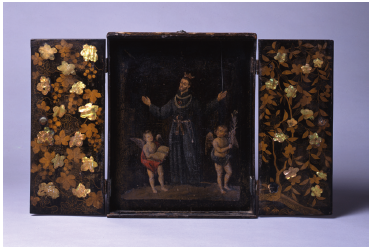
Source: anonymous. Early 17th century. 41.8 x 34 x 4.7 cm. Taiheiyo Cement Corporation (Tokyo, Japan).
Figure 5 Triptych with a painting of Franciscan saint, found in Puerto Rico
With regard to the painting, Mitsuru Sakamoto stated that Saint Peter (see figure 6) (oil on canvas, Nanban Culture Museum, Osaka) - preserved in the Kakuoji temple in Funabashi, Chiba during the anti-Christian period, and previously attributed to a Japanese painter by Tei Nishimura due to the lack of naturalism69- might have been imported from Spanish America, since it was not a work of the Jesuit school in Japan70. Similarly, Sakamoto considered The Virgin of the Rosary with Four Saints (see figure 7), oil painting on brass plate, Sendai City Museum, which was brought by Hasekura Tsunenaga to Japan, as a Spanish-colonial work71.
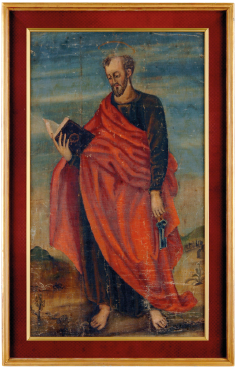
Source: anonymous. Late 16th and early 17th centuries. Oil on canvas. 119 x 69 cm. Nanban Culture Museum (Osaka, Japan).
Figure 6 Saint Peter
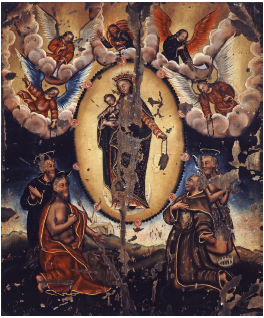
Source: anonymous. Early 17th century. Oil painting on brass plate. 30.2 x 24.2 cm. Sendai City Museum (Sendai, Japan).
Figure 7 The Virgin of the Rosary with Four Saints
Keizo Kanki delved into "Iberian-type" sacred images belonging to Japanese collections at the Symposium on Issues of Kirishitan Art, held at Sophia University in Tokyo in 1986. According to his definition, in particular dealing with kirishitan art, the term "Iberian-type" is not limited to the Iberian Peninsula, but also covers the eastern route via Goa, India, as well as the western route via Latin America and the Philippines, that is, all the territories that came under the rule of Spanish and Portuguese empires. This is due to the following five factors: 1) the flourishing of kirishitan art corresponds to the epoch of Iberian unification (1580-1640) under the reign of Philip II. Portugal, Spain, and their overseas domains were politically unified. 2) From the pictorial point of view, the Portuguese school of painting was absorbed by the Spanish one. 3) The Catholic Church and the religious orders are international organizations that went beyond national boundaries. For example, the Company of Jesus, founded by Spaniards, arrived in Japan via the Portuguese sea route. 4) After concluding the Council of Trent in 1563, Spain and Portugal immediately declared to accept the agreements of the council. Thus, Spain and Portugal united to support the policy of the Catholic Reformation. 5) The evangelization of Japan began with the arrival of the Jesuits in 1549, and Pope Gregory XIII granted them exclusive control over missions in these lands. However, in 1593 Spanish Franciscan Pedro Bautista arrived in Japan taking the western route by the Philippines. Similarly, the Dominicans and Augustinians joined the Japanese missions in 1602. In that sense, the evangelization of Japan was not a monopoly of the Society of Jesus, but works conducted while coexisting with the mendicants. There were different routes for the dissemination of Western culture and for the traffic of artworks72.
In the Western historiography, Gauvin Alexander Bailey questioned the traditional tendency to address the impact of the late Renaissance and Baroque by limiting geographical ranges to Europe and Latin America. In his research on the Jesuits' global enterprise in Europe, Asia, and the Americas, he explained the connections and the diffusion of the same devotional images (e.g. the icon of the Virgin in Santa Maria Maggiore, Rome) and European artistic traditions in different parts of the world, as shown by the arrival of Italian Jesuit painters (e.g. Giovanni Nicolao in Japan, Bernardo Bitti in Peru) in order to produce religious images and teach Western techniques. Similarly, the worldwide circulation of works by Marten de Vos and his impact in Asian and Latin American art are another example of the globalisation of Catholic art73. In short, nanban art -which implied cultural adaptation and assimilation, as well as artistic hybridization- was regarded as part of cross-cultural phenomena and global issues of the early modern era.
Alexandra Curvelo interpreted the concept of nanban as a synonym of "exotic" based on the idea of Impey and Jörg, who argued that nanban export lacquer was characterized by its "exotic" shape that integrated different Asian traditions. This definition is also applicable to the nanban screens depicting Portuguese black ships and nanban-jin, since these works aimed to satisfy the curiosity of local affluent patrons. Curvelo focused on artistic circulation between Japan, China, and New Spain. Her contribution lies in regarding Japan and Macau as the "centre of Iberian world" or the "confluence point between West and East"74. In particular, she argued the importance of Macau in the dynamics of the artistic exchange between Europe, Asia and the Americas. That is, after the expulsion of missionaries from Japan in 1614, the activity of the Jesuit seminary continued in Macau. This Portuguese trading city became "a turntable between inland China, Japan, India, Insulindia, Europe, the Philippines and the New-Spain". To exemplify her argument, Curvelo referred to nanban lacquered oratories with Spanish American images. Especially, she emphasized the circulation and demand for Mexican featherworks in China, pointing out material and documentary evidence, such as Saint Hieronymus (Museum für Völkerkunde in Vienna), and The Martyrdom of Saint Stephen (Tokyo National Museum), in addition to the letters of the Jesuit missionaries in China requesting feather pieces. Moreover, Curvelo noted a rapid circulation of European figurative models and their copies in Japan, China, and Latin America, referring, for example, to Saint Michael the Archangel, engraved by Hieronymus Wierix after a design by Marten de Vos. Considering its immediate influence on the painters trained at the Jesuit school in Nagasaki and Macau, the author postulated a possible route for the diffusion of European models in Spanish America via Macau75.
Similarly, Alberto Baena Zapatero studies networks for the traffic in artworks, focusing particularly on the circulation of Chinese and Japanese folding screens. This author rethinks the concepts of "center" and "periphery" in the trans-Pacific trade route, since the center was not Europe but New Spain, which controlled the Manila galleon through the Consulate of Mexico76. Several authors have been interested in the study of the wide circulation of Asian screens, as well as in the production of viceregal pieces which responded to the needs of emerging creoles77. How did they use them as a symbol of power by adapting and transforming objects from Asia? To what extent did Japanese screens influence existing Mexican works? How did these colonial screens acquire their own artistic identity? These issues were clarified by Gustavo Curiel and Sofia Sanabrais, who have carried out exhaustive documentary research, as well as formal and iconographic studies78. Similarly, Sonia I. Ocaña Ruiz stated the impact of Japanese nanban lacquerware on Mexican colonial works with shell inlay (enconchados). She also clarified how the hybridization of forms responded to the tastes and needs of the society in New Spain.79 The antiquary and art collector Rodrigo Rivero Lake included Mexican colonial works produced under the influence of Japanese art within the concept of "nanban art". He also brings to light new works belonging to private collections. For example, an ivory triptych representing biblical scenes is of great interest, since according to the author, this piece has the emblem of a shogun family Matsudaira at the back80.
The 400th anniversary of the Hasekura's diplomatic mission in 2013-2014 promoted the study of the relationship between Japan and Spanish overseas territories. Kazuhiro Sasaki surveyed the origins of the objects brought by Hasekura to Japan (collection of the Sendai City Museum) based on archaeological methods. He identified two swords as Sri Lankan kastane, which is decorated with ivory inlaid with silver, and Indonesian kris with the Augustinian emblem. The former was probably acquired by the Spanish crown through Portugal, while the latter must have been presented to the Spanish monarchy by the Augus-tinian Order81. Similarly, according to Masako Yoshida, the chasuble that was brought by Hasekura to Japan has vegetal motifs similar to those adorning the chasuble belonging to the Igreja de São Pedro in Faro, Portugal. But the technique of embroidery, and the style of depicting cherubs are Chinese. In other words, this was a Chinese export chasuble82. These studies question the traditional way of considering Hasekura's articles as products from Europe or Spanish overseas colonies, and show a complex network of material exchanges.
Celebrating the same commemoration of Hasekura's delegation, the exhibition "Laca Namban. Huella de Japón en España" was also held at the Museo Nacional de Artes Decorativas in Madrid. Its curatorial discourse highlights the artistic exchanges between Japan and Spain through New Spain83. As noted by Yayoi Kawamura, in the case of Spain, nanban lacquer pieces with a Baroque silverwork (e.g. the baul belonging to the church of Vilanova de Lourenzana in Lugo, Galicia) are preserved unlike Portuguese lacquer collections. This suggests that these silverwork pieces were probably added in Central America, which abounded with that metal. This fact confirms once again the importance of the trans-Pacific trade route. She also explores the global implications of nanban art by exemplifying its influences on Mexican colonial lacquer, screens and enconchados, and also analyzes the impact of Japanese motifs and frames in Pasto varnish in Colombia84. In summary, the current historiography of nanban art tends to address the phenomenon from multiple perspectives. There is an increasing recognition of Spanish America as one of the geographical regions that were connected with nanban art in one way or another.
Impact of Nanban Art in the Mexican Colonial Mural Painting
To exemplify the influence of nanban art in Spanish America, we focus on the mural cycle The great martyrdom of Japan in 1597, located on the side walls of the nave of the former Franciscan temple (now cathedral) in Cuernavaca, State of Morelos, Mexico. The discovery of this mural cycle in 1957 radically changed understanding of the influence of nanban art in New Spain. This interesting finding occurred in the process of a restructuring and restoration project, which sought to recover the original appearance of the early church85. Bishop Sergio Méndez Arceo ordered first to remove the Neoclassical high altar and collateral altarpieces, which were built in the late nineteenth or early twentieth century, and then to eliminate several superimposed stucco layers on the original flattened walls of the nave. Thus, fragments of murals depicting the prison and martyrdom of Saint Philip of Jesus and his companions were uncovered86.
These murals are composed in order to be seen from the main chapel towards the nave. The narrative scenes are developed chronologically from the south wall to the north one, taking the Historia de las islas del archipiélago filipinoy reinos de la gran China, Tartaria, Cochinchina, Malaca, Siam, Cambodgey Japón (1601) by the Franciscan Marcelo de Ribadeneira as its main literary source. The south wall is divided into large squares depicting public humiliations: the prisoners, in groups of four, are pilloried in oxcarts through the city of Kyoto (see figure 8), instead of "three for each cart" as Ribadeneira describes87; and then follows a scene where they are forced to march by means of horse carts through the main streets of Osaka and Sakai88; the north wall has no separation between scenes showing uninterruptedly the boats heading to Nagasaki (see figura 9), the Portuguese receiving them at the port, and finally culminating in a scene of martyrdom on a hill (see figure 10)89.
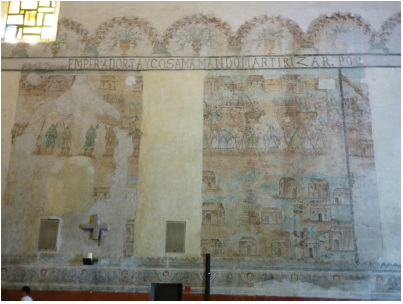
Source: south wall, detail of the mural painting The great martyrdom of Japan in 1597. Anonymous. Early 17th century. Cuernavaca Cathedral (Morelos, Mexico).
Figure 8 Public humiliations of the 26 martyrs
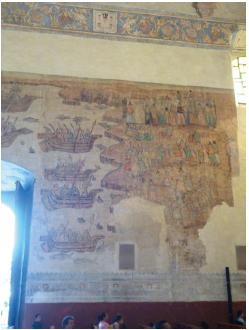
Source: north wall, detail of the mural painting The great martyrdom of Japan in 1597. Anonymous. Early 17th century. Cuernavaca Cathedral (Morelos, Mexico).
Figure 9 The 26 martyrs moving to Nagasaki by boat and the Port of Nagasaki
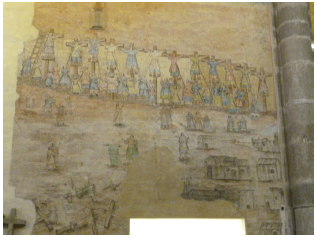
Source: north wall, detail of the mural painting The great martyrdom of Japan in 1597. Anonymous. Early 17th century. Cuernavaca Cathedral (Morelos, Mexico).
Figure 10 Great martyrdom in Nagasaki
Why was such mural cycle painted on the walls of the former Franciscan church in Cuernavaca? Different reasons have been pointed out. On one hand, the news about the protomartyrs in Nagasaki must have been received with great fervor, in particularly in the above-mentioned convent, which is located between Mexico City and Acapulco, namely, a crossing to go to Asia90. On the other hand, the creation of this mural has been associated with the coming of Hasekura's embassy to New Spain in 1614, the beatification of the protomartyrs by Pope Urban VIII in 1627, the arrival of the relics of Philip of Jesus in Mexico in 162991, and the martyrdoms of other Mexican missionaries Bartolomé Laurel (1627) and Bartolomé Gutiérrez (1632) in Nagasaki. These events had a great impact on the Church of New Spain92.
From the outset, the mural paintings of Cuernavaca have been regarded as an exceptional example of Mexican viceregal art from a compositional point of view, as well as in some details of the figures, such as the realism of the Japanese male costumes. The historiographical dispute has focused on whether a Japanese painter collaborated or not. Luis Islas García infers that these works were probably carried out by a Japanese Catholic painter who arrived in New Spain in cooperation with indigenous painters. Therefore, there is a compositional similarity to Japanese folding screens93. Masayoshi Honma also argues that there are some traces of a Japanese hand in the murals. In fact, the pictorial narrative about the history of martyrdom is developed in the manner of emakimono, Japanese horizontal picture scrolls. This historian supposes a possible collaboration of some Japanese who came to Mexico in 1614 as members of the diplomatic mission of Hasekura Tsunenaga94.
Instead, Father Pacheco (Yüki), Ota Mishima, and Fontana Calvo question the participation of an Asian painter in the execution of the murals. Even though the painting on the north wall resembles a giant screen without architectural frames dividing scenes, the details such as houses, carts, and spears are not in accordance with the Japanese historical context95. According to Pacheco, these works might have been executed by native painters who probably saw Hasekura's embassy passing by. This delegation consisted only of men. Local painters could directly observe Japanese masculine costumes, but they had to rely upon their imagination to depict female garments. Perhaps for this reason masculine clothing coincides with the kimono worn at that time, while female clothing is completely different96.
Actually, the murals do not depict correctly the Japanese context of the time. Houses are represented with stone or adobe. Moreover, the city of Nagasaki did not have a fortress -unlike other Iberian colonial cities in Asia such as Goa, Manila, and Malacca-, although it was founded by the Jesuits to be a port of exchange with Portugal. This lack of historical contextualization suggests, on the one hand, that the authors of the murals were not Japanese, but native painters; and on the other hand, that reliable information about Japan that circulated in New Spain was limited. Concerning this latter point, in preceding studies the murals in question have been interpreted on the basis of the chronicle by Ribadeneira, without taking into account the records of the martyrdom written by the Portuguese Jesuit Luís Fróis97. This academic position is justified by the publication and widespread dissemination of the text by Ribadeneira in the territories of the Spanish empire. However, from the point of view of testimonial value, Ribadeneira's records are considered less trustworthy than those of Fróis. In other words, although both chroniclers were in Nagasaki on the day of martyrdom, Ribadeneira was forbidden to go out, and had to stay inside a Portuguese ship. Furthermore, this Franciscan author had neither previous knowledge of Japanese language nor of the local society, unlike Fróis, who participated in the missionary works in Japan for over two decades and conducted research on various aspects of the country to write his Historia de Iapam. Hence, there were several limiting factors for Ribadeneira to accurately describe the Japanese environment, and the details of what happened98. This inaccuracy is reflected to a certain degree in the visual imaginaries embodied in the murals of Cuernavaca.
Concerning their figurative models, Estrada de Gerlero states that a possible visual source of these works are the canvases depicting the martyrdom, which were painted for a procession organized by Antonio de la Madre de Dios (preacher from the convent of Saint Francis in Goa, who came to visit China) in Macau at the end of 1597 in honor of the martyrs. Some Jesuits, Augustinians, and Dominicans also attended this commemoration. These paintings were reproduced and sent to New Spain and Spain; and then, Ribadeneira ordered to print them in Rome99. Considering a widespread circulation of the above-mentioned images, Estrada de Gerlero supposes that copies of these canvases must have been brought to New Spain by Ribadeneira, who was appointed as procurator of the cause for canonization of the martyrs of the Province of Saint Gregory of the Philippines100.
Fontana Calvo compares details of the murals of Cuernavaca with the two following paintings: 1) Nanban screen depicting the arrival of Portuguese ship (ca. 1593-1600), attributed to Kanó Dómi, and now belonging to the Museu Nacional de Arte Antiga, Lisbon; 2) The great martyrdom of Japan of 1622, painted probably by a Japanese Catholic author who had been trained in the Jesuit schola pictorum in Nagasaki, and fled to Macau. This work is now owned by the Church of the Gesu, Rome. The rias coastline of Nagasaki represented in the latter work shows topographical features similar to those in the scene of the arrival of the martyrs at the port of Nagasaki in the murals101. Tomoko Taniguchi also associates the representation of the martyrdom of Cuernavaca with the above-mentioned Jesuit school of painting102.
From a compositional point of view, this mural cycle was actually produced using different figurative sources from East Asia. In particular, it has a strong influence of nanban art in different aspects. First, the compositional solution of the north wall, without dividing scenes, is similar to that of Japanese pictorial art, although the narrative sequence of the murals of Cuernavaca develops from left to right, in the opposite direction to the reading order of Japanese narrative painting. This implies a compositional adaptation to the Western manner. Second, the type of boats used by the martyrs to move to Nagasaki show remarkable similarities with the boats used by the Iberians to reach the dock103, as well as the way of dressing of the Portuguese who came to meet them at the port -they are depicted wearing baggy trousers (bombachas), shirt, vest, and tall hats- and the Portuguese merchants represented in the nanban screens by the masters of the Kano school.
The influence of nanban screens on the murals of Cuernavaca is due to two main reasons: 1) the circulation of Japanese artworks in New Spain; 2) the close ties between the missionaries and the painters of the Kano school in Japan. Regarding the first issue, several sources testify to the traffic of a large number of Japanese objects in the Americas. Particularly, since the beginning of the seventeenth century, the relationship between Japan and New Spain became closer as a result of the undertaking of the missionary work of the mendicants in the Japanese archipelago; the arrival of Rodrigo de Vivero in Japan after a shipwreck in 1609, and his audience with the Tokugawa Shogunate; and the diplomatic mission of Hasekura Tsunenaga. According to a Japanese source entitled Date jike kiroku 伊 達治家記録 (Records of the Date clan), more than a hundred commercial products were loaded into the ship in which Hasekura and his entourages journeyed; likewise, other objects and folding screens that had been commissioned by the shogun Tokugawa Ieyasu were transported as gifts for dignitaries104. Similarly, Mexican indigenous chronicler Domingo Chimalpahin stated that they brought many iron objects, desks and some clothes to sell in Mexico. Spanish explorer Sebastián Vizcaíno, who came back on the same ship, was in charge of guarding all the presents that the "Emperor of Japan" (Tokugawa) gave to the Pope, the King of Spain, and the Viceroy of New Spain105. According to the letter sent by Vizcaíno, "five boxes of screens" arrived in 1614 among the gifts of the shogun Ieyasu to the viceroy Velasco106. Thanks to these sources we know that the gifts brought by Hasekura included luxury items and screens. It is also worth noting that the arrival of these objects coincides with the time when most of the nanban screens (today 91 pieces identified around the world) were produced, between 1587 and 1613107.
With regard to the second issue: the relationship between the missionaries and the painters of the Kano school; according to the missionary documents, a master of the Kano school, called "Cano Pedro" or "Guensuque Pedro" 源助ペドロ, was the trustee of the Franciscan Order in Kyoto in the time of Father Jerónimo de Jesús, and was, along with three other fellow painters of the same city, very close to friars. Cano was "the leader of those painters"108. Therefore, the group of local painters headed by Cano Pedro might have produced Catholic images to supply the demand of the Franciscan community in Japan. Moreover, all this information was provided in a statement made by Cano himself before the Bishop Luís Cerqueira in Nagasaki on March 6, 1603, before Cano embarked for Luzon at the approximate age of 40. However, it is difficult to prove whether he actually went to the Philippines, since the signature of Kano Gensuke Pedro 狩野源助平渡路 appears in a petition for sanctification in honor of the 26 martyrs, signed by twelve Catholic representatives of the Kyoto-Osaka region on December 25 of the same year109.
We know through historical documentation that this master had several names: as a Christian painter he signed Pedro Cano ペドロ狩野 or Cano Gensuke Pedro 狩野源助ペドロ or Kiya Dōmi Pedro 木屋道味平渡路, while as a genre painter he was known as Tosa Dōmi 土佐道味 or Kanō Dōmi 狩野道味. Noteworthy is that among works attributed to this painter there is the portrait of Saint Francis Xavier (figure 1)110, which was produced in the Jesuit schola pictorum using as figurative source the engraving by Hieronymus Wierx111. If this attribution is true, the following hypothesis arises: Cano Pedro, who learned Catholic art in the Jesuit seminary, probably also contributed to the production of Franciscan painting in Japan. Similarly, other work attributed to the same author is the nanban screen (ca. 1593-1600) housed today in the Museu Nacional de Arte Antiga in Lisbon. It is suggestive that Fontana Calvo found an analogy between Portuguese entourages depicted in this screen and those of the mural painting of Cuernavaca112. Undoubtedly, Cano Pedro is a key influential person in the artistic exchanges between Japan, Europe and the Americas. A task for the future is to delve more deeply into the relationship between the missionaries (both the Jesuits and the mendicant friars) and the painters of the Kano school, as well as into the degree of impact of the Jesuit schola pictorum on both sides of the Pacific Ocean.













